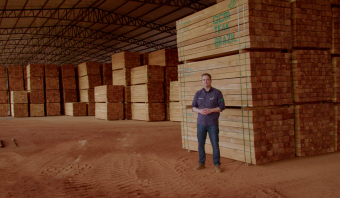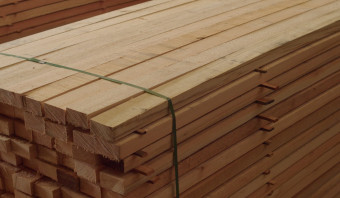06 de agosto de 2024

Engineered Wood: The Future of Construction in Brazil
The fifth episode of the WoodFlow Podcast brought an important debate to the wood market: How can engineered wood contribute to more sustainable construction?
According to UN data, the construction sector emits about one-third of the world's greenhouse gases (GHGs). In Brazil, according to a survey by the Ministry of Science, Technology, and Innovation (MCTI), 6% of national emissions come from this sector. These were some of the topics discussed in the fifth episode of the WoodFlow Podcast, which focused on the sustainability of wooden constructions and the concept of engineered wood.
WoodFlow CEO Gustavo Milazzo led the conversation with three industry specialists: Patrick Reydams, Consultant and expert in engineered wood; Leonardo Lenz, Partner at Immergrün Intelligent Constructions; and Martin Kemmsies, Consultant and Sales at Latam Wood Industry. They discussed topics ranging from the culture of civil construction in Brazil to the opportunity of having engineered wood as a main sustainable ally to reduce GHG emissions in this sector.
What is Engineered Wood?
Engineered wood is the term used for wood products that have applied and applicable engineering. It consists of layers or strips of wood glued together using special adhesives. This includes products like Laminated Veneer Lumber (LVL), Cross-Laminated Timber (CLT), Glue-Laminated Timber (Glulam), among others.
Each of these products is applied to a specific construction element. For example, CLT is a panel used for walls and slabs, while Glulam is used for beams and columns. This technology allows for precise knowledge of the density and load capacity of each element, making it possible to calculate where each beam or column is needed, similar to masonry.
Benefits of Engineered Wood
The main benefit of building with engineered wood is sustainability. While masonry constructions have a negative emission balance, wooden buildings have a positive one. "Being made from a natural and renewable raw material - wood - in addition to removing carbon from the atmosphere (through the photosynthesis process while the tree is growing), this carbon remains trapped in the wood throughout its useful life," highlighted Martin Kemmsies.
Challenges and Market Bets
Among the challenges pointed out by the interviewees is the national culture of civil construction, which favors masonry structures. "There is still the perception that wooden houses are those made of planks and associated with a lower standard of construction," said Patrick Reydams. However, the reality of modern wooden constructions is completely different. "Today we have a house completely built in a factory, and only the assembly is done on the construction site. Not to mention that the construction time is much faster compared to masonry," explained Leonardo Lenz.
The interviewees emphasized the need for more research investment into the behavior of these structures in our tropical climate. "Much of the technology we brought from northern hemisphere countries, where the technology is more developed, but pests like termites are not present. Perhaps a solution is to learn from countries with climates similar to ours, such as South Africa," added Martin.
Finally, as an opportunity, the debate highlighted the importance of public policies to promote and encourage wooden constructions in Brazil. Patrick highlighted projects such as the New Research and Innovation Arrangement (NAPI) for engineered wood, funded by the State of Paraná in the city of Guarapuava (PR). There, representatives from the state, the private sector, and universities are working to develop products and also to promote the technology of engineered wood construction.
"In addition to this example, another alternative is government incentives and public financing for such constructions. We need to see schools, hospitals, and other public buildings made of wood to encourage this cultural shift," said Martin.
About the WoodFlow Podcast
The WoodFlow Podcast is an initiative of the wood export startup WoodFlow, aiming to discuss the wood market once a month. WoodFlow CEO Gustavo Milazzo conducts the interviews, always portraying the scenario and the future of wood. The WoodFlow Podcast is the first in the country to discuss wood market topics and can be accessed directly on YouTube or audio streaming platforms.
Posts Relacionados

09 de dezembro de 2025

